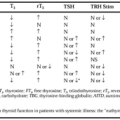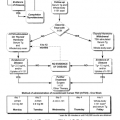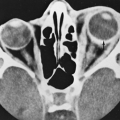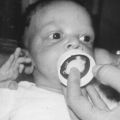CLINICAL FEATURES OF NONTOXIC GOITER
Part of “CHAPTER 38 – NONTOXIC GOITER“
HISTORY AND PHYSICAL FINDINGS
Patients with nontoxic goiter have no systemic symptoms, and the goiter is usually found on routine physical examination or is detected by the patient as a neck mass. Local symptoms occasionally include those due to tracheal compression (stridor or respiratory distress) and/or displacement of the esophagus (dysphagia). Rarely, substernal extension of nontoxic goiter may lead to recurrent laryngeal nerve entrapment and hoarseness. Spontaneous hemorrhage into a goiter manifests as local pain and tenderness in one thyroidal lobe. When Hashimoto thyroiditis causes nontoxic thyroidal enlargement, the gland is usually without local symptoms but diffuse tenderness or adenopathy occasionally occurs (see Chap. 46).
History-taking from patients with nontoxic goiter includes a focused review of possible environmental or genetic factors that may be causative. The emphasis is on dietary or medicinal sources of excessive iodine intake, antithyroid drugs, or, in regions of the world where iodine deficiency or naturally occurring dietary goitrogens are common, on establishment of a possible role for these factors. Goiter during pregnancy or the enhancement of established thyromegaly in successive pregnancies should raise the possibility of marginal iodine deficiency. Low-dose head-and-neck irradiation in childhood increases the risk of nodular goiter and thyroid carcinoma.44 Systemic illnesses such as sarcoidosis or amyloidosis raise the rare possibility of infiltrative disease of the thyroid. Isolated thyroid nodules in the euthyroid patient often indicate adenomas or cysts (see Chap. 39). Cancer originating in other organs may (rarely) metastasize to the thyroid.45 At autopsy, infection of the thyroid is relatively common in patients who have succumbed to septicemia, but such involvement is seldom clinically apparent before death.46
Stay updated, free articles. Join our Telegram channel

Full access? Get Clinical Tree







